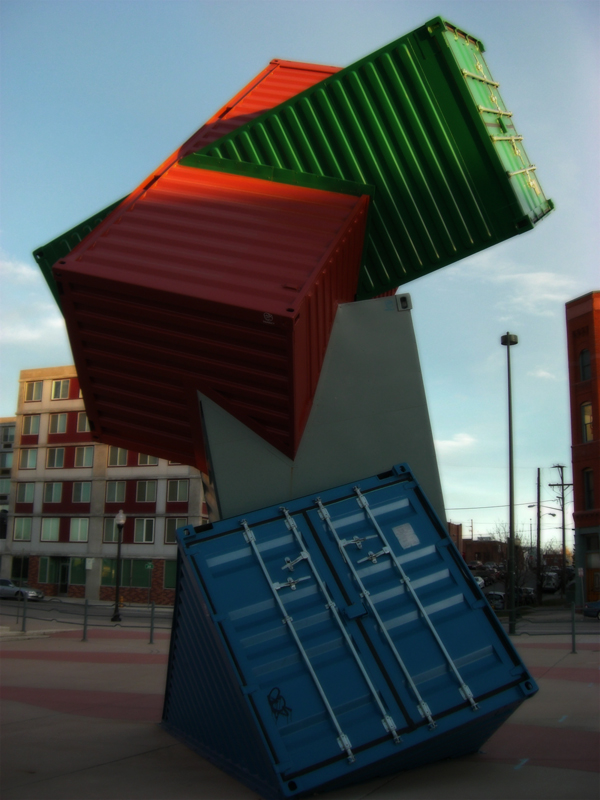The transformation of the River North (RiNo) neighborhood from industrial black hole to an emerging arts district has been one of the more interesting local urban trends of late. While both private development (the TAXI development, for instance) and public dollars (including planned streetscape improvements to Brighton Blvd.) are being invested in the area, the gritty character remains – which has to date led to a neighborhood renaissance unlike any other in town. The determination of the community to retain its bohemian-arts quality in the face of economic growth, which typically leads to a sterilization of the “real” aspects of place, has been a key influence in the rise of RiNo.
One of the more delightful aspects of RiNo’s emergence has been the integration of public art as gateway feature to the neighborhood. Starting with the “Trade Deficit” installation by Joseph Roche in 2009 at multiple points along Broadway, which refers both to the area’s industrial history and its arts-future, sculpture has become both a literal and illusory gateway to the neighborhood. More recently, Mike Whiting’s “Rhino” and “Pinky and Mr. Green” (also on Broadway, at Larimer and Walnut Streets) have been added to the mix – creating a whimsical transition to the neighborhood.
The relationship of both the media and subject matter depicted in these pieces to the context and character of the RiNo neighborhood is an intriguing example of marking perceived or real community boundaries. Throughout our history, many Denver neighborhoods have been “defined” through the use of monuments as boundary marker, usually with the name of the ‘hood permanently etched in stone. While there is nothing inherently wrong with this style of gateway, they do nothing to describe the history or character or quality of the place. Perhaps the effort in RiNo to mark its gateways with elements that either conceptual or directly speak to its unique character may serve as an example to other Denver neighborhoods.













I live in RiNo and I love all of these pieces that have been popping up lately – the new arrow sculpture is pretty cool too. Yet I always wish that the “Trade Deficit” pieces could be used as anchors for creating better public space for northern Downtown. Their progression of rising out of the earth as you travel down Broadway could be really great as an urban public art experience. The largest one, at Broadway + Blake has a large area around it almost as if it’s meant to be a gathering place, and yet it is mostly fenced off, discouraging people from going there (I can’t help but think a few plants might make it more appealing also…). The intersection of the diagonal grid with Broadway makes for some really interesting spaces and in a neighborhood sorely lacking public space, these could really add to the city’s urban experience if they were more inviting and people actually realized they were entering a “district”. It’s hard to tell when you whiz by in a car. There needs to be some encouragement and good reason to interact with these pieces on foot, they are great!
Read an interesting article recently about the medical marijuana growing requirements for each dispensary (sorry, can’t remember where… Post?) and how this is driving demand to keep warehouses and industrial zones as just that (or perhaps industrial agriculture zones). RiNo was mentioned in particular. That some planned resi conversions are mothballed as lucrative warehouse leases are secured for large scale growing operations. Do you think this is real or is the economy really to blame?
I took a picture of the new “arrows” art when they turned it on a couple weeks ago. I like this new piece a lot more than “trade deficit.” The piece of it in front of my building is too small to understand and too far from the larger pieces to seem cohesive. Here’s a photo of the arrows sculpture:
http://yfrog.com/64msotj
You can see part of “trade deficit” in the background.